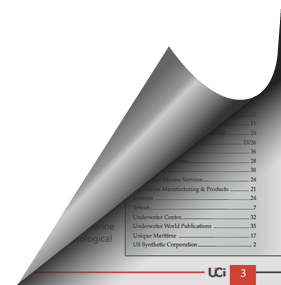
The Magazine for Underwater Professionals
![]() Oct/Nov 2018
Oct/Nov 2018
PRODUCT EYEBALL
Deep impact
Trelleborg's strong focus on product development and its ability to successfully implement new technologies were just the skills that oil giant Chevron needed when it was faced with an underwater pipe problem
Deep search of new oil deposits means new challenges. To avoid pressure on pipes that can cause buckling, rotating buoyancy modules that slide on the seabed are a solution. Image: Trelleborg
Chevron, like every other oil producer, is going ever deeper in search of new oil deposits. This means that it needs to use high-pressure/high-temperature piping in the oil extraction process. But because these kinds of pipes move and expand, they can literally dig themselves into a trench on the ocean floor in which they can no longer move. That puts pressure on them and can cause buckling.
The oil industry has a solution for this – buoyancy modules that slide on the seabed, but these come with their own drawbacks. “The problem is not a new problem,” explains Antonio Critsinelis, subsea pipeline team leader with the Chevron Energy Technology Company, based in Houston, USA. But Chevron “realised there was room for improvement,” he adds.
So Chevron developed a new solution, buoyancy modules that rotate on pipes, which would prevent the high-pressure piping digging too deeply into the sub-ocean soil. And having developed the solution, Chevron decided it needed a partner to do large-scale testing of its patented new technology and bring it to market.
DESIGN
After opening up a design competition, Chevron selected Sweden-headquartered Trelleborg. Chevron needed a partner “who was not just research focused but could produce a product we could use,” explains Kale Lundeen, a subsea engineer at Chevron Energy Technology. Trelleborg’s “technical team was very knowledgeable and good at their job,” he says.
For the tests, Trelleborg recreated undersea soil conditions in order to find out how various soil compositions would react to the new buoyancy modules.
Trelleborg then created testing equipment that could utilise rapid prototype techniques to look at a variety of design concepts, explains Adam Grady, new product development engineer, Innovation & Technology Department, within Trelleborg Offshore & Construction. It also built a testing rig that could test models of the modules in a simulated seabed. Formulated analytical calculations were then made that could predict module embedment and traction in the subsea floor.
Once computational modules verified the findings, a full-scale test bed was built to evaluate an actual module in simulated seabed clay.
CLAMP
Trelleborg also added some key features to the Chevron technology, such as fins on the modules to keep them from digging too deeply into soil. It also added a clamp that allows the modules to rotate and enables quick installation of the modules on vessels that lay the offshore pipes. The company spent nine months testing and developing the modules.
Kale Lundeen predicts that the technology could prove a game changer in the world of subsea pipelines, as does Steven Bray, customer group manager, Subsea Customer Group, within Trelleborg Offshore & Construction. “This is a technology that will provide significant technical and commercial benefits to other operators and fields throughout the world,” he says.


